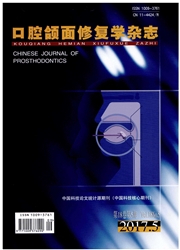

 中文摘要:
中文摘要:
目的:探讨偏侧咀嚼对紧咬牙运动时大脑皮层激活的影响。方法:选取左、右侧偏侧咀嚼患者各7例,采用时段设计方法,采集偏侧咀嚼患者紧咬牙运动时全脑血氧水平依赖对比的功能性磁共振成像(functionalmagnetic resonance imaging,fMRI)扫描数据,以SPM2软件包进行数据分析。结果:偏侧咀嚼患者在紧咬牙运动时,均显示了初级躯体运动感觉皮层(primary sensorimotor cortex,SI/MI)、岛叶、前额叶皮层、顶叶皮层和颞叶皮层的激活。在P〈0.001,激活区cluster≥3个体素的参数条件下,组分析结果显示两组之间存在以下不同:(1)右侧偏侧咀嚼患者左侧SI/MI比右侧激活更强烈,而左侧偏侧咀嚼患者右侧SI/MI比左侧激活更强;(2)左侧偏侧咀嚼患者显示了辅助运动区的激活,而右侧偏侧咀嚼患者未见该区的激活;(3)两组偏侧咀嚼患者均有左侧额下回和左侧顶下小叶的激活,且右侧偏侧咀嚼患者该区激活更强烈。结论:(1)偏侧咀嚼习惯影响了大脑皮层的激活。(2)SI/MI对偏侧咀嚼患者紧咬牙运动的调控可能具有对侧半球优势。
 英文摘要:
英文摘要:
Objective: To explore the effects of chewing-side preference (CSP) on cerebral cortex response during clenching task. Methods: Two groups of right-handed subjects were seven subjects with left CSP and seven subjects with right CSP. All the subjects performed the maximum voluntary clenching in intercuspal position, and block designed BOLD functional MRI scan covering the whole brain was carried out. The fMRI data were analyzed by SPM2 software with statistic t-test. Results: During the clenching task, the primary sensorimotor cortex(SI/MI), insular, prefrontal cortex, parietal cortex and temporal cortex were activated in the subjects of two groups. And there were some differences of group map (P〈 0.001, cluster ≥3) analysis as follows: (1) the BOLD signals of contralateral primary sensorimotor cortex SUMI was stronger than ipsilateral SIfMI in subjects with left and right CSP. (2) Supplementary motor area (SMA) was detected in subjects with left CSP. However, there was no activation in subjects with right CSP. (3) The left inferior frontal gyrus and left inferior parietal lobule were more significantly activated in patients with right CSP than left one. Conclusions: 1.CSP may change the character of brain activity during clenching task. 2.There may be some relationship between contralateral hemispheric dominance and chewing-side preference in SI/MI responsible for clenching task.
 同期刊论文项目
同期刊论文项目
 同项目期刊论文
同项目期刊论文
 期刊信息
期刊信息
